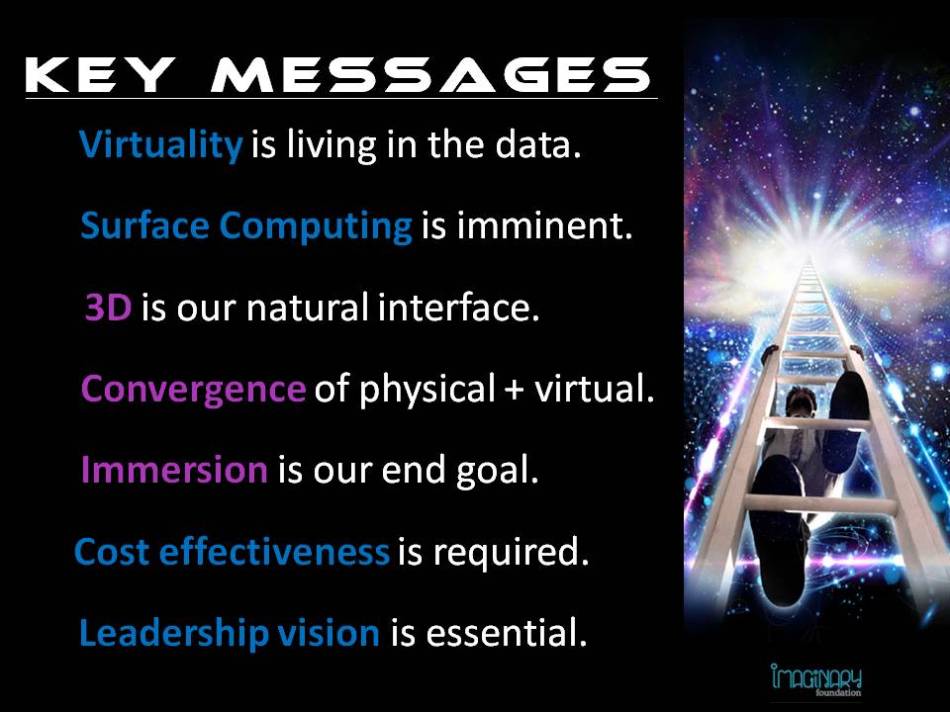The Virtual Worlds Best Practices in Education begins tomorrow.
There is a trend in conferencing coming that is unstoppable. That trend is virtual conferencing. I don’t mean virtual conferencing with Skype like services, where you see a video of someone talking and a set of Power Point presentations on some media board. I mean the replacement of physical conferences.
We’ve talked about it for the last five years – virtual worlds are ever present and they are going to be replacing live events. Well, we are being hit at a less transcendental level — our pocket book, and even more defining — policy. It’s simply too expensive to travel to conferences in Orlando, Washington DC, New York, San Diego. It costs our companies far too much money to send several people. It costs an enormous amount of money to house the folks who attend conferences and even more to feed them all.
If cost isn’t enough to not sign every requisition that passes your desk, the Department of Defense is simply telling people “you can’t go”. You need papal dispensation to even go to a conference across the street from your facility. And, you’ll likely be on a furlough anyway that day, so if you do go on your own, it’s now going to cost YOU money to go to the conference. The Department of Defense is a big employer in the USA. Do you think that policy will extend to your organization? Yup.
So, the solution that we’ve all been talking about is staring us right in the face. We can recreate the physical experience of going to a conference in a virtual environment. In a virtual environment you can place all sorts of 3D objects in the environment. If you can place a 3D object in the environment, chances are people are going to know what to do with it. If they touch it, slide it, bounce it, move it around, it’ll likely do something that will make them think about why that is happening. If they look at something, anyone in the environment standing by them can look at what they are looking at, and suddenly, you know what someone is paying attention to.
This kind of interaction is exactly what it’s like to attend a conference in a physical location. Sure you can’t eat the local food, or meet a couple of new people in a bar to talk about the conference, but you can bring your own food to your computer, and still meet new people in a bar and talk to them about the conference. There is no compromising here really. The argument that face to face is extremely important just isn’t that important anymore. 1/3 of relationships have started on-line. Virtual schooling is soaring. Collaborative work across virtual environments is becoming the norm.
You can do lots of things in front of your computer that you can’t do in the physical world in a room full of people during a presentation. You can’t watch a video, or chat rapidly (well, you can Tweet with your thumbs), or you can’t ALT TAB and open several windows at the same time and reference your little heart away, looking at things someone is talking about. You can’t run a program demo, or group up with five other people to back chat. But, you can do that in a virtual world. And even way more!
I guess, I’m going on about something everyone knows. But, the point is virtual conferencing is coming, and innovation is going to be happening even more than we originally suggested. The question becomes how do you now make a conferencing interesting. How do you make it more than just sitting your avatar in a chair and listening to a Power Point presentation.
It is now incumbent upon the presenters and the conference organizations to figure out how to engage the avatar, transform virtual world learning and begin to define, mold and support virtuality. Here’s a start http://www.youtube.com/watch?v=lKP7eLofqfk
I’m ready to dig in and take it way beyond our imagination. How about you? Attend the virtual worlds best practices in education and start thinking about it hard. http://www.vwbpe.org
See you there. And at your next conference too. Call me!
